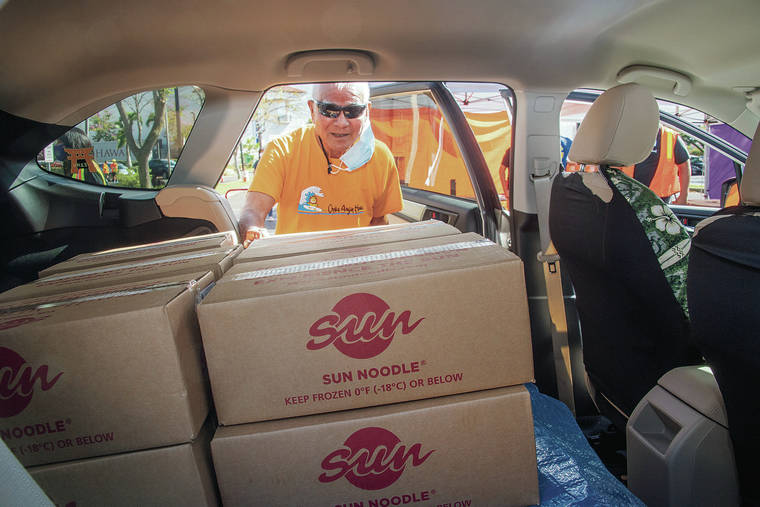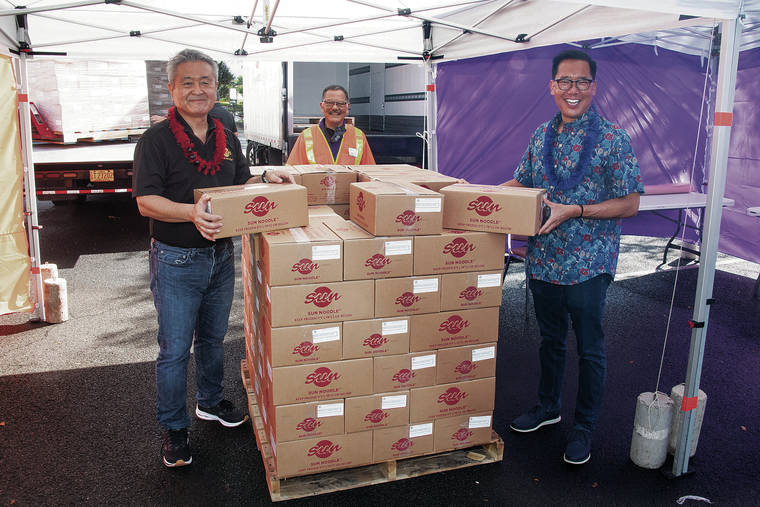Oahu’s move to Tier 3 is only a step toward recovery

CRAIG T. KOJIMA / CKOJIMA@STARADVERTISER.COM
Howard Takada of Oroku Azajin Hawaii, looks over his load of Sun Noodle he picked up Sunday for his Okinawan club. The Hawaii United Okinawa Association had a drive-thru pickup of 500 boxes of Sun Noodle products, donated by the Central Pacific Bank Foundation, at its headquarters in Waipio.

CRAIG T. KOJIMA / CKOJIMA@STARADVERTISER.COM
Hidehito Uki, left, CEO of Sun Noodle, Patrick Miyashiro, HUOA president, and Keith Amemiya, executive director of the CPB Foundation, at the pickup site Sunday.


Oahu is on track to move to Tier 3 of its COVID-19 reopening strategy this week after being stuck in Tier 2 since October, but some businesses are unsure what Tier 3 will mean to them and how much of a change it will bring.
The state Department of Health on Sunday reported one new coronavirus-related death on Oahu and 33 new cases on the island.
For Oahu to move to Tier 3, the island’s seven-day average of new cases must be below 50 on two consecutive Wednesdays. Also, the seven-day average positivity rate must be below 2.5% on those two Wednesdays. Oahu met those metrics Wednesday and appears likely to met them again this Wednesday.
Sunday’s seven-day average case count for Oahu was 27, and the seven-day average positivity rate was 1.1%, according to Honolulu Mayor Rick Blangiardi.
If the numbers stay at roughly that level, the county could move to Tier 3 on Thursday.
The mayor said last week that he hopes Oahu can move to Tier 3 this week. Tier 3 permits social and outdoor recreational gatherings of 10 people, up from five currently, and restaurants can seat 10 people at a table, also up from five now.
Don't miss out on what's happening!
Stay in touch with breaking news, as it happens, conveniently in your email inbox. It's FREE!
For restaurants, group size may be less important than capacity, according to Kevin Yim, vice president of marketing and communication for Zippy’s Restaurants.
Tier 2 allows 50% capacity in restaurants, but that restriction appears to be lifted in Tier 3.
Yim said it isn’t clear what changes to capacity would be made, although it’s a far greater detail for restaurants.
“Moving up to 10 people is great. That’s fantastic — don’t get me wrong. But moving beyond 50% (capacity) would be even better,” Yim said.
Under Tier 3, gatherings for funeral services would expand to groups of up to 25. Currently, it’s limited to 10 people.
Scott Power, president of Oahu Mortuary, said many of its funeral services before the pandemic would include gatherings of 150 to 200 people. Shrinking that down to 10 people has been hard for grieving families, he said.
But allowing 25 people only begins to solve the problem, Power said.
“To be limited to 10 people is very difficult. Twenty-five is better, but it’s still far from where we would want to be in terms of providing that closure when someone passes away,” Power said.
He said Oahu Mortuary, along with other mortuaries, have allowed drive- thru services to give other friends and families the ability to pay condolences.
A deceased person could be placed outside under a canopy for viewing, but those driving through are limited to giving condolences from the inside of their vehicles.
“It’s a far cry from being able to get out of your car, give somebody a hug and kiss, and spend a few minutes with them sharing your common knowledge and appreciation of the person that’s passed away,” Power said.
Tier 3 would also allow groups of 10 people at zoos, sea life attractions, aquariums, museums and botanical gardens, up from groups of five people and 50% capacity in indoor areas.
But moving to Tier 3 doesn’t make a difference for the Waikiki Aquarium, which has been closed for months and will remain closed even with the more relaxed restrictions.
Andrew Rossiter, the aquarium’s director, said social distancing guidelines, rather than group size, is the problem.
“What we’re looking at is, are they going to reduce the individual distance restrictions? Because when people are in our galleries, it’s challenging to stay more than 6 feet apart from one another,” Rossiter said. “It’s not so much the size of the groups that come in; it’s the individual space restrictions.”
It hasn’t been economically viable for the aquarium to operate since coronavirus restrictions have been in place. Rossiter said he’s had to lay off 14 full-time employees, leaving fewer than 20 employees, most of whom work in facilities maintenance or with the live exhibits.
“I honestly held out as long as possible, just to keep people employed,” Rossiter said. “But it was unavoidable. We would have gone bankrupt if I extended it another month.”
City Council Chairman Tommy Waters is “cautiously optimistic” about the city’s reopening.
“I’m excited for businesses, but at the same time I’m concerned for our kupuna,” he said. “We’re still not out of the woods. … This is a health problem. If you solve the health problem, you solve the economic problem.”



